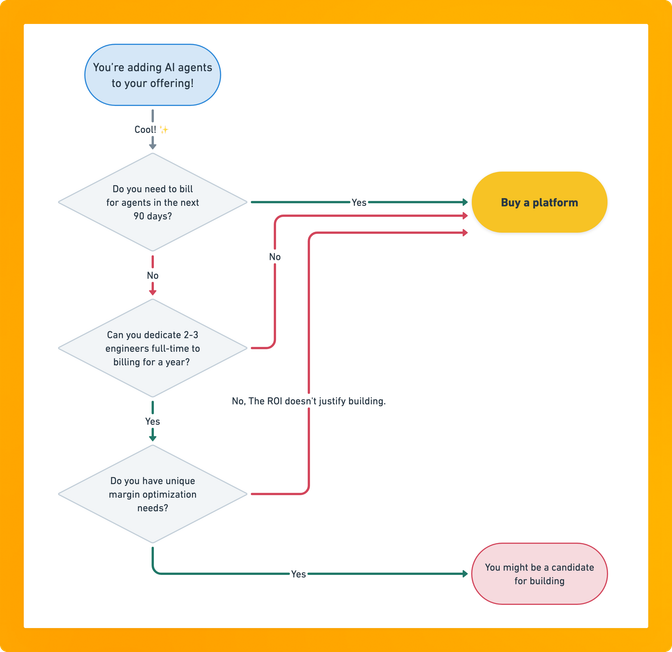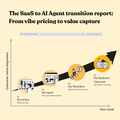Build agents and get paid
Understand your margins and get paid for the value your agents create.



You added agents to your previously seat-based SaaS product. Now you need to bill for them. Should you build billing infrastructure or buy it?
This guide helps you decide in under 10 minutes.
Answer these three questions:

Your SaaS billing won't work for agents. Here's why:
SaaS billing typically assumes | Agent Reality |
|---|---|
Fixed number of seats | Variable agent deployment (2 to 30+ per customer) |
Predictable usage patterns | Autonomous 24/7 operation with usage spikes |
Humans trigger actions | Agents make decisions independently |
Features drive value | Outcomes drive value |
Business hours consumption | Continuous operation across timezones |
The bottom line: Forcing agents into seat-based pricing leaves money on the table and confuses customers.
Yes. Companies switching to outcome-based agent pricing see 20-60% revenue increases within 6 months.
Cost Category | Building | Buying Paid |
|---|---|---|
Initial development | $500K - $2M | $0 |
Time to first invoice | 6-12 months | 2-4 weeks |
Engineering team | 2-3 full-time engineers | 0 dedicated engineers |
Ongoing maintenance | $200K-$500K/year | Included |
AI provider integrations | You build and maintain | Automatic updates |
Tax compliance | Your team monitors | Automatic updates |
Feature development | Months per feature | Configure or request |
Year 1 total | $700K - $2.5M | Platform fees only |
Year 3 total | $1.1M - $3.5M | Platform fees only |
Edge cases consume you. Custom deals, tax changes, failed payments for autonomous agents.
Maintenance never ends. AI providers change APIs monthly. You track and implement updates forever.
Opportunity cost kills you. Every hour on billing is an hour not improving your agents.
Capability | Why It Matters | Build Yourself | Buy Paid |
|---|---|---|---|
AI cost tracking | Track spend across OpenAI, Anthropic, Google, etc. | Maintain integrations forever | Built-in, auto-updated |
Outcome-based pricing | Charge for results, not resources | Design data model, build engine | Configure without code |
Margin visibility | Know profitability by customer/agent | Build analytics infrastructure | Real-time dashboards |
Value reporting | Prove ROI to customers | Build customer portal | Drop-in components |
Fast implementation | Start billing quickly | 6-12 months to MVP | 2-4 weeks to invoice |
Flexible pricing | Change models as you learn | Rebuild when requirements change | Configure on the fly |
Build only if you meet ALL these criteria:
If you checked all five boxes, calculate total cost over three years. Compare to buying. Factor in opportunity cost.
Most companies that pass this test still buy when they see the numbers.
Buy if any of these are true:
Use this checklist when evaluating:
Some teams try to split the difference. Build part, buy part.
I've been there, and this usually fails.
Why hybrid doesn't work:
You maintain integration points between systems. You need deep billing expertise for both. You inherit complexity of building AND constraints of buying. However, edge cases fall into gaps - debugging spans your code and the platform and then extends into RevRec systems, ERPs, and data warehouses for analytics.
When changes touch multiple systems, you are trapping yourself in maintenance hell.
The only exception:
Buy core billing engine. Build thin customization layers on top through APIs.
This requires clear boundaries and discipline, and incredible depths in the business processes both for the now and the future. Most companies let customization spread until they've rebuilt half the platform.
We built Paid specifically for agent billing after seeing companies waste months building what exists.
This is the most common mistake. The MVP never stays minimal. I've personally spent 3 years building billing systems for SaaS and B2C companies - it will eat up 8-14 engineers' time and you'll spend 3-4 months building, then discover you need tax compliance, dunning logic, outcome attribution, margin tracking, and dozens of other features.
Companies going this route end up rebuilding after 6-12 months. By then, you've lost a year of proper monetization.
Paid supports outcome-based, workflow-based, hybrid models, and custom signals. Most "unique" requirements are configurable, not custom.
Test this: explain your requirements to other agent companies. If they understand you, a platform can handle it.
Yes - a thousand times yes! Companies switching to outcome-based pricing see 20-60% revenue increases within 6 months.
Seat-based pricing breaks when customers deploy variable numbers of agents. Outcome-based pricing aligns revenue with value delivered.
Paid uses standard APIs and exportable data formats. Your usage tracking uses OpenTelemetry.
The real lock-in is building yourself. You're locked into your technical decisions, team expertise, and maintenance burden forever.
Show the numbers:
Total cost over 3 years to build and maintain vs buying.
Opportunity cost of engineers on billing instead of product.
Time to revenue: 2-4 weeks vs 6-12 months.
Ask: is billing where we want our best engineers focused?
Yes. Lower risk than building first.
Start billing quickly with Paid. Learn real requirements. If you discover truly unique needs, migrate with real data.
Most companies never need to migrate. The platform handles everything as they grow.
Data shows 20-60% increases within 6 months.
Pricing aligns with value. Customers deploy more agents when pricing makes sense. Renewals improve because ROI is clear.
One customer cut seat prices 50%, added outcome fees, and saw 60% revenue jump in 90 days.
Your existing SaaS billing probably won't handle agents well. Seat-based systems break with variable agent deployment. Usage-based systems struggle with outcome attribution.
Evaluate whether extending makes sense or if purpose-built agent billing is better. Most companies find agent billing different enough to warrant new infrastructure.
An absolute majority of SaaS companies should buy agent billing infrastructure and not build it. The opportunity cost is massive. The 5% that should build have genuinely unique models, or billing as competitive advantage.
For everyone else, focus engineering on better agents, not billing logic.
Ready to start billing for agents?
Understand your margins and get paid for the value your agents create.




Price smarter. Protect margins. Grow revenue.